Review: Down in Flames: WWII – Aces High (DVG) and comparison with DiF (GMT)
Posted by Denny Koch on November 3, 2010

Game: Down in Flames: WWII – Aces High
Publisher: DVG
Published in: 2008
Designer: Dan Verssen
Era and Topic: World War II / ETO and PTO / Air combat
Components: 110 Full color Action Cards, 110 Full Color Aircraft Cards, Full Color Rulebook, Full Color Counter Sheet (88 – 5/8” counters), 6 Full Color Campaign Sheets
Game Type: Card based wargame
HFC Game-O-Meter: D 
Our Rating (1-10): (Rating for experienced DiF players / Rating for casual gamers who don’t know the original)
Graphic Presentation: 9
Rules: 6
Playability: 6/8
Replay Value: 3/9
Overall Rating: 5/8
| PRO | Great artwork; very modern design; high production quality; strong glossy coated full-color cards, counters, and rules; fast gameplay; new actions cards; new fighter ratings (firepower, two Horsepower ratings); PTO and ETO; new maneuvering system with speed and action cards; tactics cards; almost no setup time; fighters can attack in chains and be attacked by several other fighters which provides dynamic dogfights… |
| CONTRA | …which are more ahistorical because of the removal of wingman rules; campaign extremely simplified; elimination of almost all simulative aspects of the classic campaign game; only one bomb mode (no more level, saturation, torpedo bombing etc.); simple hit system; simple bombing system without random element; no more variable mission length; no ingress / egress / target / home bound turns; simple Flak rules; no crews; rules describe only 1 vs 1 dogfights for simplicity – but are raising questions for 2 vs 2 (or more) dogfights; ambiguous rules and wording; some rules only mentioned in examples |
A preliminary note or warning:
This is not only a review about DiF – Aces High, but also a detailed comparison between the “new” DiF series and the “classic” DiF series by GMT Games. Many wargamers who enjoy the classic GMT series (and own several modules and expansions) are wondering whether they should “switch” to the new system. Information about the differences and about who should switch – and who should not! – are sparse and scattered all over the internet.
Our intention was to review the new Down in Flames series from a wargamer’s perspective who played and enjoyed the classic series, especially the campaigns, and to give you veterans an overview over what to expect from the new system – and what not!
Introduction

Shoot down your enemies… out of the sun!
In 1993, GMT Games published the first module of the Down in Flames series, “Rise of the Luftwaffe“, depicting WWII air combat in Europe, designed by Dan Verssen, Gene Billingsley, and Rodger McGowan. In 1995, the second module, “8th Air Force” was published. The game series was then further supplemented by two Pacific modules (“Zero” and “Corsairs and Hellcats“) as well as several smaller add-ons published in GMT’s C3i magazine.
The first two modules are out of print by now and there are no plans of reprinting them. Instead, GMT announced a new game which will replace the first two modules and serve as a modern update: “Wild Blue Yonder“. This game is still in P500 status and when (and if) it will hit the market is unknown.
Update 2017: The game is available now!
If you want to get into the classic and very popular “Down in Flames” series, you have to search eBay or other marketplaces for Luftwaffe or 8th Air Force, and you can expect that it will cost you a nice amount of money. The Pacific expansions are still available at a reasonable price, but if you want to “own them all”, it will require some dedication (and money) to become a “Down in Flames” pilot.
But wait… what about the relaunch of “Down in Flames” by game designer Dan Verssen? Why should I bother collecting the “old stuff” when there is a brand-new, revised, modern version available?
In 2008, Dan Verssen published his own new version of “Down in Flames” in his own company, DVG (Dan Verssen Games). The first game was “Aces High“, supplemented in 2010 by “Guns Blazing” and several smaller card expansions. The new version is not compatible with the old GMT Down in Flames series, but was announced as an advanced, revised new game which improves many aspects of the old game while streamlining the Campaign game (which was quite simulative and of moderate complexity in the old games, so the designer felt the need of making the Campaign more accessible to casual gamers).

WWII air combat on your gaming table!
But should you really sell your entire GMT DiF collection and switch to the new, improved version of Down in Flames with modern and stylish graphics, more fighter abilities, more and different action cards, more maneuvering options, more color, more fun?
The answer is: you could – if you are a casual gamer or a gamer who enjoys playing the basic dogfights variants of the original game and who never touched the campaigns because they were too complex for you, or who always thought the wingmen rules were too static (disregarding historical leader and wingmen tactics which were even more static, so that the RAF pilots were actually dubbed “Idiotenreihen” (rows of idiots) by German fighter pilots due to their rigid and static formations). You will get improved graphics and a more dynamic dogfighting system than in the original game and you will certainly enjoy the new look and feel.
But beware – if you are an experienced wargamer who loved the GMT DiF series, and especially the campaigns, you should avoid the new game system! While the dogfights and several basic mechanics benefit from the new rules and action cards (reducing historical accuracy but enhancing gameplay), the Campaign game is simplified beyond recognition and won’t satisfy you if you loved the old Campaigns – on the contrary, we were heavily disappointed by the dumbed-down Campaign rules.

Aces High: the components
Besides this, the original rules (which consist of two 22-pages-rule books in 8th Air Force) are now condensed into one 24-pages rulebook. The campaign rules, formerly filling a rulebook of their own, are now drastically shortened and integrated into the basic rulebook. The shorter rules are not only caused by a reduced complexity, but also by a new wording which is more ambiguous and less extensive than in the old rule books. They certainly aren’t sufficient to please a classic-GMT-DiF-player, so read this review before considering to sell your old games on eBay!
As we stated in the initial warning, this review of “Aces High” gives a general overview over the DVG game, but also serves as a comparison between the old system and the new system from a wargamer’s point of view, because many wargamers are interested in the question whether they should sell their old games and switch to the new system – or whether they should stick to the GMT games.
Hopefully, our review will help them to decide whether they would enjoy the new game (a more casual gamer with a preference for simple dogfights who loves exciting graphics and thinks the old system to be too static and old-fashioned certainly will, so no game-bashing is intended!) or be disappointed.
What is Down in Flames anyway?
“Down in Flames” is a card-based wargame about Air Combat in World War II, WWI and post-war. Players control single fighters (German, British, Polish, Russian, US, Japanese) and conduct dogfights against other fighters. Fighters maneuver against each other, trying to get an advantaged position from which they could shoot down their enemies. The best position is tailing the opponent, but since each player wants to tail the enemy, there’s a lot of maneuvering until one fighter is behind the other and that’s what makes these dogfights a thrilling and fun experience.
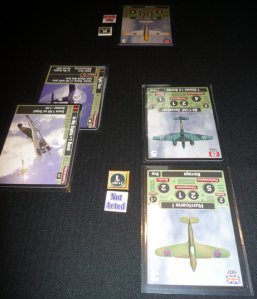
A dangerous situation: being tailed in a dogfight!
Maneuvering and attacks are resolved by drawing action cards. These allow for attacks and flight maneuvers (Barrel Roll, Yo-Yo, Tight Turn, Loop etc.). Players then can respond to actions by conducting counter-actions from their card hand. Specific maneuvers counter other maneuvers.
Besides the dogfight variant, which is perfect for a quick in-between air combat match, the heart of the game is the “Campaign” mode. Players play a historical Campaign (for example the ‘Invasion of Poland’ 1939 or the ‘Battle of Britain’ 1940) by conducting several missions in a row. In contrast to dogfights, players also fly bombers during a campaign and bomb specific targets while the defender defends the targets with Flak. Fighter escorts try to protect the bombers on their way to the target while defenders try to shoot down the attacking fighters and bombers before they reach their destination. The outcome of the Campaign is calculated at the end of the final mission by comparing victory points accumulated during the missions.
In the classic GMT DiF, Campaigns have a rulebook of their own where the bombing and special campaign rules are described in detail. In the DVG version, Campaign rules are much shorter and much simpler, so that it’s next to impossible to compare the Campaign rules with each other – the GMT Campaigns are complex and challenging, while in the DVG game, they are not much more than an extended dogfights version with chit comparing at the end.
Graphic Presentation and production quality
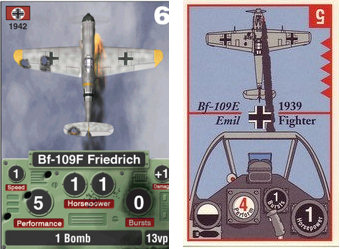
A DVG Bf-109F (left) and the a GMT Bf-109E (right). The graphics in the new game are much more appealing, that’s for sure
The graphic presentation of Aces High is excellent – the new fighter and action card artworks are great and were one of the main reasons why we took a look at the game in the first place. The graphics of the old “Luftwaffe” and “8th Air Force” are not too appealing in their 3-color-print and their somewhat stale and old-fashioned design. Functional, but not exciting. The Pacific modules “Zero” and “Corsairs and Hellcats” are full color and have more modern look, though. The same is true for Aces High – the illustrations are really impressive and dynamic, and we greatly enjoyed the new and look & feel.
The rule book and counters are full-color and with a modern look, and the box art is stylish, so the graphic presentation of the game is excellent and definitely superior to the older DiF games (at least to “Luftwaffe” and “8th Air Force”).
The cards are glossy coated and of a strong cardboard quality with a very good haptic “feel”. The color on the black borders is somewhat problematic because during our first shuffling, we realized that the black color wasn’t too resistant against being touched and shuffled, so we put the cards into sleeves.

The pilots are printed on strong cardboard counters
The cardboard counters had to be punched out first, but we had to apply some force to push them out of their frames. Counters in other games (especially games by FFG) can be punched out more easily, but in the end, it wasn’t much of a problem. At least they don’t fall out of their frames during shipping.
All in all, Aces High looks great and much better than the GMT predecessors, even the more modern full-color Pacific modules Zero or Corsairs. Nothing to complain here, the game design is stylish and appealing.
Rules
The rule book consists of 24 full-colored pages. The layout is visually appealing with much chrome and cool illustrations. Unfortunately, we aren’t too happy with the rules wording and structure. The worst problem is certainly caused by the fact that the entire rules are written for the simplest possible constellation, a 1 fighter vs. 1 fighter dogfight.
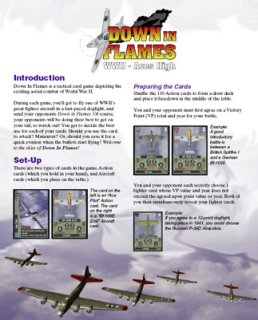
The full-color rulebook layout is very modern and visually appealing with lots of illustrations for additional chrome
Since 1 fighter vs. 1 fighter engagements isn’t something you want to do all day long, you soon want to fly more fighters, even if you only play dogfights without ever touching the campaign! But as soon as you choose a second fighter, problems arise. “Flying multiple aircraft” is described in the “Optional Rules” section (!), while all rules and examples in the main rules section deal only with 1 vs. 1 engagements. This causes more questions than answering them. It would certainly be more helpful if the rules described a basic 2 vs. 2 air combat because a redux down to 1 vs 1 isn’t much of a problem if you want to use fewer aircraft, but trying to apply 1 vs 1 rules to a multi-aircraft-dogfight is very cumbersome and forces the players to flip the pages back and forth and makes the examples almost useless.
In addition, some rules are not written in the rules text (as you would expect), but only appear somewhere in an example. In our opinion, examples are meant to explain a rule further, not to replace a rule entirely (and not only because we are nitpicking, fussy ASL players). A rule should be written in a clear, self-explanatory fashion that deals with all possible outcomes or effects, using examples only to underline one interesting aspect or to illustrate the rules further for different situations. You should not be forced to read all examples (and even pages of sample dogfight turns), but only consult an example when you feel the need to learn more about the practical issues of applying a certain rule.
The wording of the rules is simplified compared to the very extensive wording of the GMT rules. Admittedly, those were sometimes even too extensive where a simpler sentence would have done the job as well or even better (for example the “draw a card when diving, discard a card when climbing rule” which was rather long-winded in the GMT game). The classic rules were far from perfect and often cumbersome, but the simpler wording in the new game don’t make things better, quite the contrary.
While the GMT DiF rules were not optimal, the designer now actually missed the opportunity to clarify and streamline the original rules in his revised version. Instead, the wording became more ambiguous and left us with some questions we couldn’t solve without consulting internet forums. The classic rules were confusing sometimes, and you had to browse the rules back and forth, but in the end, you could always find an answer to your question – we were never forced to search the internet for a clarification. Aces High definitely isn’t a rules clarification for the old game – if you are looking for revised, rewritten, streamlined, clearer, well-sorted version of the original rules, you will be disappointed.
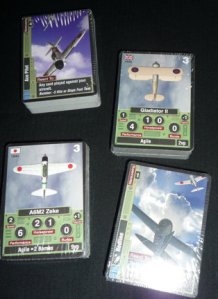
There are new action cards as well as PTO and ETO aircraft
Some of the new elements introduced with the new game have potential, but in the end, they are only dealt with in a few sentences which leave you with questions you have to solve with logic and by interpretation. A single sentence, a few words more sometimes would have worked wonders. Examples are the new “Speed Maneuver” rules that explain the situation where a fighter compares his speed rating with the speed rating of an enemy fighter. If the speed rating is higher, the pilot gains free maneuver points against this fighter and can change their position. During our first reading, we were somehow misled by the rules and discussed whether a slow fighter which is pursuing a faster fighter can maintain his pursuit or whether he was outdistanced if the speed was lower than his opponent’s speed. We came to the conclusion that you only profit from a higher speed rating, but don’t have any disadvantage if your speed is lower, but a few more explanations would have been nice.
Another problem are the Wingmen rules. The new game doesn’t have any Wingmen cards anymore, you can voluntarily declare that two fighters form an element, but the elaborate Wingman rules from the classic games have been eliminated. You don’t learn much about the “optional Wingman rule”, though. The rules state that you can voluntarily pair two fighters and that this would provide leader and wingman with an increase in Horsepower, but they don’t state when you pair them up (at start? During the game?) and whether you can dissolve the element or pair up with a different fighter later during the game. Later on boardgamegeek, the designer told us that you “choose to have two fighters form an element at the start of the game and that they cannot change, switch, dissolve, or reform during the game”. Including this simple and clear sentence into the rules would have avoided many questions in the first place.
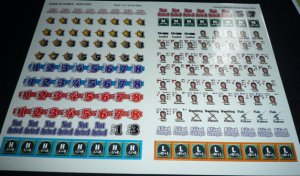
The glossy, full-color counters are of a very strong cardboard quality
What we were missing deeply are designer’s notes (we’ve been missing those in the classic game as well, but the new game would have been the perfect chance of including them into the rulebook). A game that uses abstractions and calculates many aspects of air combat into different fighter ratings, would profit from some short explanations of what was symbolized by this and that feature, for example the somewhat strange rule of having a maximum number of bursts against different aircraft where you first “spend” your inherent burst, then your advantaged burst, then your tailing burst points, regardless of how many fighters you attack, up to a maximum modifier of +3. We had difficulties to get the simulative meaning of this rule (besides from the gamey fact that it limits the number of bursts during a turn).
In addition, explaining the various fighter maneuvers in short descriptions or illustrations would also enrich the rules. In a game where maneuver is crucial and players conduct several flight maneuvers, a short explanation of what a Barrel Roll, Yo-Yo, Loop, or Scissors maneuver is about would be helpful in creating an authentic atmosphere. Not every player is an experienced fighter pilot (or XBox pilot, as we are…) and some explanations like this would have been helpful to make the players understand what they are actually doing when playing a certain card.
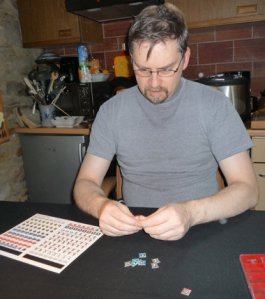
It took some effort to punch the counters out of their frames
All in all, we got the impression that the rules wording was intended to be an easy, cool, and fast reading in order to apply to casual gamers, but in fact it is somewhat lax and sloppy here and there. The game would indeed profit from a more precise wording for the price of longer, dryer rules. In most cases, it’s only a small sentence, a short clarification, a few words that’s missing and which would be sufficient to improve a rule, no epic novel-writing is required.
Generally, wargames are in fact a collection of rules accompanied by some other stuff like counters and maps and when the rules are sub-par, the whole game suffers no matter how shiny the components are. You could play a game where you only have the rulebook and not any other component by simply drawing the counters and the map yourself, or using a GAP like Vassal or Cyberboard, surely not the preferred way to play a game, but the point is, you could do it. If the rules are unclear however, you have a serious problem even with the best counters and the most impressive map, so for wargamers the rules are most important, the rulebook is the game!
The full-color illustrations are good and helpful, nothing to complain here. The rulebook design is fresh and modern and graphically appealing.
If you want to take a look at the rules, you can download them from the official DVG website here (PDF, 2.5 MB).
Gameplay
The game looks great, the rules have room for improvement but are otherwise sufficient for quickly getting into the game (especially if you are an experienced DiF player who has some previous knowledge). So how does the new Down in Flames actually play, compared to the classic GMT series?
There is no simple answer to this question, it’s more of a “Better in some aspects, much worse in others“.
Changes in the new game system
There are many similarities with the classic game, especially regarding the fighter cards. DiF players will immediately recognize the different ratings on a fighter card: Horsepower, Bursts, Performance, and hit points (Airframe). But wait, there are several new ratings on the fighter cards as well: instead of only one horsepower rating, there are now two ratings: pre-turn and post-turn horsepower. And also a ‘firepower’ rating or modifier, a ‘speed’ and a VP rating.

A classic: The Spitfire I
On the other hand, where are the bombs? Okay, some fighters have a “Bombs” number printed at the bottom of the card, but no more “Level” or anything like that. We will learn what happened to the bombs and bombing in general later in the campaign section of this review.
Besides adding new ratings to the fighters, another important change is the elimination of wingmen cards. In Aces High, you can pair up any two fighters to form a leader-wingman-element, but you don’t have any specific wingmen ratings any more and only rudimentary rules dealing with this combination. Using wingmen became optional and in the basic dogfighting game, you usually won’t use an element but single fighters who are free to fly where they want. Sounds good? Well, maybe but there are wingmen rules in the classic game for a reason…
This is another important change to the old system: In DiF GMT, fighters could only be engaged with one other fighter. In DiF DVG, fighters can be attacked by a maximum of 3 fighters, one tailing, two advantaged, while tailing or having an advantage over another fighter. Fighters which are tailing or in an advantaged position can be attacked from three sides while they are attacking, so forming aircraft chains is a common procedure. You can also attack more than one aircraft in a single turn instead of one aircraft per turn, as in the classic game. This sometimes results in awkward situations and can become problematic if the combination is too complex because the rules are written for 1 vs 1 dogfights. Dogfights with multiple aircraft are dealt with in a short paragraph named “flying multiple aircraft” and is strictly optional, so the simplified rules and 1 vs 1 examples don’t cover all possible constellations and situations that can show up in a game session. As mentioned before, writing rules from a 2 vs 2 perspective would have helped a lot – mentally dumbing them down to 1 vs 1 while reading is much easier than ‘upscaling’ the rules for a multiple aircraft combat – this only causes black holes because specific situations are not covered in the rules and the players are forced to search for interpretations – and that leads to unnecessary rules debates slowing down a game that is meant to be played fast.
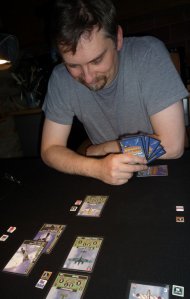
Andreas’ Bf-109E is tailing my Hurricane I
Another important new feature (which we actually consider to be an improvement) is the more flexible maneuvering system. In the classic game, you had to play a “Maneuver” card if you wanted to change your position against an enemy fighter. If you didn’t have a Maneuver card, you didn’t have a chance to get behind him. We never really had a problem with that since you can always see possible explanations for not having the right card at the right time (the pilot didn’t see it coming, the plane is not reacting as it should, the pilot is not skilled enough to react that fast, he’s tired etc..)
In Aces High, each Action card can alternatively be used as a Maneuvering card and has a “Maneuver” value printed in the upper left corner. The more valuable a card, the higher the maneuver rating. With an “Ace Pilot”, you get 4 Maneuver points which could bring you from being tailed to advantaged in one maneuver. Only the cheapest and most common card, the Barrel Roll, doesn’t have any Maneuver points. This forces the players into interesting and hard decision-making: Do I keep the valuable “Out of the Sun” attack card to later attack my opponent, or do I use the 3 Maneuver points to get free from my pursuer?
In addition, each game turn has a new phase now called “Speed Maneuvering“. In this phase, you compare your speed to that of another aircraft (you must compare it to an aircraft you are pursuing, or you can break the pursuit and compare it with any aircraft on your flight level from a neutral position). If your speed rating is higher, you get free Movement points and can change your position freely without paying with Maneuver cards. The rules could be somewhat clearer regarding Speed Maneuver in dogfights with multiple aircraft, but in the end, the new phase is a very good idea and adds the tactical decision of which fighter to use against which enemy.
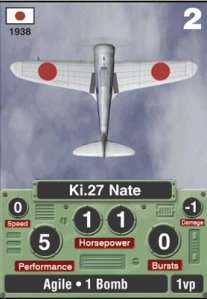
A low horsepower rating can ruin your day at high altitudes…
Your Horsepower rating still determines how many cards you draw each phase, but you get two card-draw phases each turn instead of one at the end of your turn. Before your game turn starts, you have the “Pre-turn draw phase” where you draw cards up to your “Pre-turn Horsepower rating” (up to a maximum of your performance rating which still determines your maximum hand size). At the end of the turn, you get a “Post-turn draw phase” where you draw cards according to your “Post-turn Horsepower rating”. Both ratings are still affected by your flight level, but in a slightly different way (High altitude only reduces your pre-turn draw while low altitude only increases your post-turn draw). The effects of flight level on card draw are printed on the level counters, which is a good idea.
The action cards (which now have a very cool and dynamic artwork, showing ETO and PTO aircraft in combat) are further enhanced by tactics cards. Tactics are played on your own aircraft and your opponent cannot counter them. Tactics can give you more attack power, reduce damage, or have other (temporary) positive effects on your fighters. The action cards also introduce new maneuvers (Yo-Yo, Redline, more types of In My Sights), and the response system is somewhat more elaborated in the new version of the series.
Last but not least, aircraft now have a damage rating. In the original game, firepower damage was calculated into the Burst rating, but designer Dan Verssen came to the conclusion that this led to a clumping of capabilities, actually obliterating the differences of the various planes used in WWII. In his new game, Burst is the measure of how many guns an aircraft has, while Damage is the shell size. By splitting the rating, it became possible to depict the differences between fighters who had the same burst ratings in the original game, for example the Spitfire I and Bf-109E which both had a burst rating of 1. Since the Spitfire had lots of light machine guns and the Bf-109 had medium cannons, both now get different ratings. The Spitfire has a burst rating of 2 (fast machine guns) with a damage of -1 (few hits, high spread) while the Bf-109 has a burst rating of 0 (slow cannons) and damage +1 (high damage when hit). The net count is still 1 (as in the original game), but the new stats add some historical and technical accuracy. This is another aspect which is definitely an improvement and what we really like.
While the new cards, new maneuvering options, and new fighter ratings add more dynamics to the game, the campaign game was drastically simplified (which is indeed one of the biggest changes to the original series, much to the regret of veterans of the game series) to make it more attractive to “non campaigners” who avoided the complex campaign game of the original game. In addition it was the stated designer’s intend to remove any “random or luck elements” from the campaign (the card draw for bombing and flak), because he felt it could be a source of frustration if you prepare your bombing for an hour or more, bring your bombers into the target area, only to miss the target by an inch. Well, whether it was frustrating or realistic (bombs were not auto-guided missiles then and they did miss), is a matter of taste – you may prefer a more “gamey” approach over a more realistic but sometimes frustrating approach, but that’s again depending on what you expect from a wargame as a whole and what type of wargamer you are. More about the changes in the campaign game later!
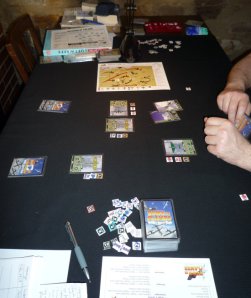
The game requires only moderate table space
Victory Conditions
A dogfight is won when all enemy fighters are shot down (or after turn 6, whatever comes first). Aircraft now have a victory point value (right lower corner of the aircraft card). You add the victory points of all fighters you shot down or damaged (=flipped to the damaged side which is worth half the VP) to get your score.
In a campaign game, you play a series of missions which also generate Victory Points depending on shot down planes and damaged/destroyed targets.
Sequence of Play
There is no Player Aid Sheet or Reference Sheet included in the game, but the Sequence of Play and Mission Sequence is printed at the bottom of the Campaign Log Sheet. The classic DiF offered small Sequence of Play cards which were quite useful, especially because they were so small (on the downside, they contained a misprint which was later corrected by a card errata). The sequence of the new version isn’t very complex or long, but since the game is intended to appeal to casual gamers, they would certainly profit from a small Reminder card which doesn’t require much table space. Players don’t use Campaign Log sheets during dogfight games, so they probably overlook the Reference section of the sheet.
There is no more difference between the SoP in the dogfight game or the one in a campaign. The campaign now simply is a dogfight (with additional bombers) and when the dogfight part is over, you compare chits (Flak and bombs) and the mission is over. Therefore, the Sequence described in this paragraph is true for both game variants, but the campaign adds bombers to the show and some other elements which will be described later.
Start of the Game
At the beginning of a dogfight, all players agree upon a Victory Point limit (for example 25) and a year (for example 1943). They then secretly choose aircraft with a total of VPs not higher than the agreed-upon limit. Aircraft have a year printed on their cards which is the year they came into service. If you agree on a year, you can choose any aircraft from this year or previous years.
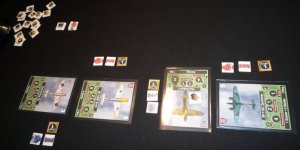
A “fighter chain”: The Hurricane I is disadvantaged from two sides. One of the advantaging aircraft is tailed by another Hurricane.
You can then decide to pair two fighters into a leader-wingmen element but in contrast to the original game, there are no separate wingmen rules, except from the fact that the wingman can only play cards against fighters which are currently engaging their leader instead of cards against any aircraft on the same level. The advantage of forming an element is that the leader gets a +1 modifier for Pre-turn Horsepower and the wingman gets a +1 Post-turn Horsepower modifier. This rule is optional, you don’t have to use any wingmen at all (and we suppose, most players won’t). If you are interested in historical accuracy, you probably would, but then you would prefer the elaborate wingmen rules from the original game anyway, where wingmen were different fighter cards with different ratings and their own set of rules. In a simple, friendly dogfight, you will in the end have more fun when you allow all aircraft to fight each other in a wild chain of planes tailing, gaining advantage, tailed, advantaged etc..
Players then secretly select a starting altitude for their aircraft. Aircraft can fly at five different altitudes: very low, low, medium, high and very high. Only fighters with turbochargers can start at high or very high altitudes. Altitude has an effect on horsepower (the higher the fighter, the more engine power is required) and only fighters at the same altitude can engage each other. Later, fighters can change altitude by climbing or diving.
After the altitude is chosen, an initial card hand is drawn for each aircraft (a number of cards equal to the performance rating). Players keep the cards for each aircraft separately (we misused the Allied / Axis-Number counters to mark which card hand belongs to which aircraft, for example by designating one aircraft and the respective card hand with the number “7”, because the planes frequently change position on the table). The game can be played by up to 6 players who fly in teams (Allies vs. Axis) or in a free-for-all match (which is too ahistorical for our taste). Two players with 2 fighters each should give you a good impression of the new dogfight mechanics when you learn the game, but you can add as many aircraft as you like.
Each aircraft has its own ‘slot’ within the player order and completes all steps of the Sequence of Play before it’s the next aircraft’s turn.
1. Pre-turn card draw
The player draws a number cards equal to the Pre-turn horsepower rating of the active aircraft (taking any altitude modifier into consideration). The maximum card hand is the performance rating, so if the maximum is reached, no more cards are drawn.
2. Adjust Altitude
The aircraft can adjust altitude by one level (climb or dive). If the aircraft dives, the player draws one card (it is allowed to exceed the maximum card hand size for this purpose only). If the aircraft climbs, one card must be discarded. If there are no cards in the card hand, the aircraft cannot climb.
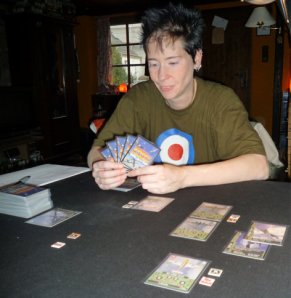
A larger card hand provides more flexibility
Any pursuing aircraft can then decide whether they want to follow their prey. A tailing fighter can freely follow by discarding or drawing a card in the same manner as the active player. An aircraft in an advantage position over the enemy fighter has to pay 1 card plus the cost (discard / draw) if it wants to follow to a different altitude.
Since a higher altitude has a negative effect on horsepower, it is possible to outmaneuver a weaker pursuer by climbing to very high altitudes where he is reduced to -1 Horsepower (which would result in stalling). Stalling itself is a very cool idea and adds some realism; unfortunately, the stalling rules are not consequent and only half-cooked, wasting some interesting simulative potential. The stalling rule is much too short and the wording is again open to interpretation (when does the rule take effect, whenever the condition is met, or once? Each time Horsepower is calculated? If I payed the stalling penalty of 1 card, can I remain on the high altitude forever, provided I don’t care about the -1 card draw? Does it mean that I have to pay a card instead of drawing one each time I am entitled to draw cards in the post-turn draw phase? Is it only relevant if I don’t have any cards while reducing myself to -1 HP? Questions like that will drive you crazy and it will come to a full stop in the midst of a game because the rules say nothing about that). Apart from the wording, we really liked the main idea of outracing a fighter with a weak engine on very high altitudes because stalling was and is a common problem and adds some realism.
3. Speed Maneuvering
In this phase, the active aircraft compares speed with another aircraft on the same altitude. If the fighter is tailed, disadvantaged or neutral, it can compare speed with any aircraft. If the fighter is currently tailing or has advantage over another fighter, it has to compare the speed with this fighter or break the pursuit if the owner wants to compare the speed with another aircraft.
Speed only has any impact if your speed is higher than the enemy’s. You then get free Maneuver actions for each point your aircraft’s speed is higher. Each maneuver action based on such a free point is “as if you play a maneuver card from your hand”, which means that you can change your position by one if you have one point (from tailed to disadvantaged, from neutral to advantaged etc.), or more if you have more points. Your opponent can respond with cards that counter “Maneuvering” like he would do when you play a Maneuver card in the action phase.
If your speed is lower than your opponent’s, nothing happens. This seems somewhat weird if you are the one who is tailing another aircraft because in reality, your target would simply outrun you. I guess outrunning slower aircraft was avoided due to simplicity, but it would have added another tactical layer in choosing the right aircraft for the right job and the potential for another dimension in the game is clearly there with the new speed maneuver phase/rating. Another missed opportunity here.
4. Actions
In this phase, the aircraft can play action cards. You can play action cards as ‘maneuvers’ or ‘actions’ (attacks or tactics) and the opponent can respond to each action by playing the appropriate reaction card. Most action cards have an action and a reaction box and the reaction box details which actions the card can respond to.
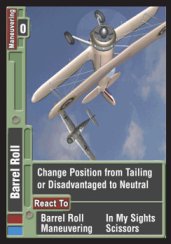
The “React To” section lists the maneuvers you can respond to with a Barrel Roll
You can then respond to your opponent’s response and he can respond back, and this chain of actions & reactions can go on as long as the players have cards which respond to each other (or until one player gives up because he wants to save a response card for later). If you played the last response to which the enemy is not able or willing to respond anymore, your initial action happens. If your opponent plays the last response, your initial action is cancelled.
You can play as many actions as you wish, but you cannot make as many attacks as you like. Attacks are performed by playing attack cards (Out of the Sun and In my Sights), but you must pay in “Bursts”. Each attack card lists the number of bursts required to play it. Aircraft have a fixed inherent burst rating which can be increased by an advantageous position (having advantage: +1 burst; tailing: +3 bursts). That means even aircraft with an inherent burst rating of “0” can play attack cards for up to 3 bursts if they are tailing their opponent.
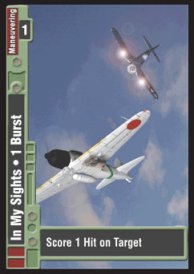
This “In my Sights” attack card costs 1 Burst and scores 1 hit on the target
Unfortunately, the (optional) section describing attacks against multiple aircraft is somewhat confusing and the example isn’t very helpful either. The rule only describes a default situation but doesn’t give any clue of how to deal with any different combat constellation.
In one of our games, Andreas was tailing me. He spent one burst to shoot my aircraft down, then maneuvered against one of my other aircraft and got into an advantaged position. We had a long debate about how many bursts he had left and whether he could use the advantaged burst bonus after having attacked me from a tailing position because the rule isn’t too clear here. On the contrary, we found this rule very confusing (it is clear that it was written with the intention of prohibiting the use of “advantaged” fire several times in a single turn, but in fact the paragraph raised more questions than answering them). Especially the sentence “Bursts are used in order of: inherent, advantaged, tailing” and the example in which players use bursts in exactly that order were not helpful in our situation. In addition, the example added more to the confusion because it contained information not evident in the rules. This was a real game-stopper for us which required us to turn on the laptop and do some research, where we discovered that many questions in forums are about playing with multiple aircraft and bursts.
The rules section for “flying multiple aircraft” is too short, definitely, and the rules should have been written from the “multiple aircraft point of view” in the first place. Much confusion could have been avoided.
Aircraft have a certain number of “Hit Points” (called Airframe rating) which is the number in the upper right corner of the card. Once the aircraft suffered a number of hits equal to or greater than the airframe, the card is flipped to the “damaged” side while keeping the damage markers on it. On the damaged side, the stats are drastically reduced and the picture shows the aircraft tailing smoke. Even the control panel with the different stats has bullet holes which is a cool idea and adding to the atmosphere. If the airframe number on the damaged side is reached, the aircraft it is shot down and out of the game.
After you positioned your aircraft and conducted attacks, the action phase ends.
5. Discard
You can now discard as many cards from your hands as you like (for example, if you have reached your hand size maximum but want to draw new cards).
6. Post-turn Draw
At the end of the turn, the aircraft’s owner can draw as many cards as their Post-turn Horsepower allows (if you are on higher altitudes, this number is reduced).
This ends the turn for this aircraft.
Since a dogfight only lasts six turns, the game is quite fast and can be over quickly.
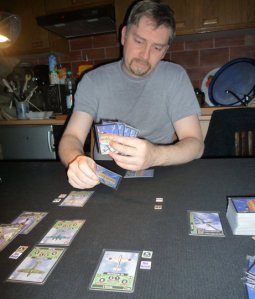
It always hurts if your opponent responds to your response…
The gameplay of action -> response -> response to response etc. is dynamic and because the fighters are free to engage any enemy fighter, there is much more movement on the table than in the original game. The new maneuver options and the possible attack chains allow for more flight maneuvers and card constellations, so the dogfight actually feels more dynamic. Fighters can now save their companions by attacking an enemy who is tailing their partner by tailing him themselves. In one game, one of my fighters was almost shot down by the enemy and trailing smoke, but then my other fighter dived down and began to attack my pursuer from behind – shooting him down eventually and saving his colleague’s life.
Long chains of attackers, wild maneuvering, switching positions, free flying all around the table is not very realistic in terms of how air combat in WWII was actually like (the wingmen-leader formations were very tight and rigid and was loosened only at the end of the war, so that the static gameplay of the original game is closer to reality and more accurate). On the other hand, the new stats (especially firepower divided into bursts and damage, speed, two horsepower etc.) add a new layer of accuracy and detail.
In gameplay terms, if you can see over the historical facts and the problematic wording, the new dogfight system is very entertaining and cool and we had fun pitting our fighters against each other in dogfight. Together with the improved graphics, dogfights offer a great feeling of immersion.
If you are only interested in quick & dirty dogfights from time to time and don’t care much about precise rules wording or anything like that, you could actually enjoy the game.
If you are a fan of the original campaign game, you should read on because we now reach the heart and soul of Down in Flames:
The Campaign
If you ask a Down in Flames (GMT) player what he likes most about the series, most of them will probably answer: the Campaigns. Why? Well, as wargamers or consim players, replaying historical campaigns is one of the reasons why we love our hobby, isn’t it?
To a wargamer, the dogfights are nothing more than a warm up exercise or something he plays as a filler between two larger games. They are quick, they are fun, but they are… well, dogfights. Some planes fighting each other until one side is shot down. Nice, but not too meaty.
Aces High contains 6 historical campaigns (Poland 1939, Battle of Britain, Battle of Midway, Battle of Stalingrad, Guadalcanal, Daylight Bombing 1944). Each campaign is presented on a campaign sheet with some historical information, a map with planes and arrows pointing to objectives and other information. The graphical presentation is much better than in the original game, the sheets look interesting and “authentic” while the old campaign sheets had a boring black-and-white look.
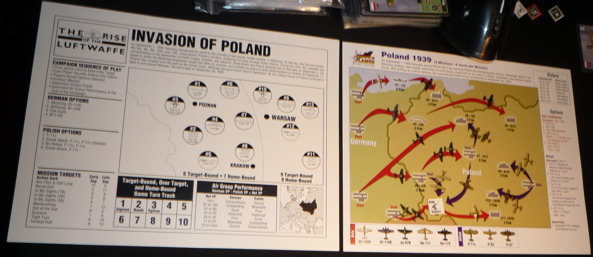
Invasion of Poland – then and now
On second glance, you realize that something is amiss, though. Where are the target-based, over target and home-bound tracks? Where are the map sectors? Well, you don’t need them anymore because all missions have a fixed length (Poland: 4 missions, 6 turns per mission, except when using the “Winds” option in the PTO campaigns which add or subtract 2 turns.).
In the original game, you chose an objective where you sent your bombers (for example, an airfield). The number of turns it took you to reach your target depended on the number of sectors you had to cross, there was actually a certain sense of distance. When you were near your target and reached the hot zone, you first entered the “over target” part of the mission where you had to fly through the Flak, then throw your bombs, and eventually leave the hot zone. After that you had to fly back home on a track where the defender could wait with an ambush to shoot you down even after you had done your job. Fighters could also choose to fly into the flak fire together with the bombers, and defending fighters risked being attacked by friendly flak if they engaged you in the target area.
In Aces High, the player with initiative (first turn: Axis in the Poland campaign) chooses one of the locations labeled with “AT START” and declares which arrow he will follow on his first mission. Bomber symbols show which and how many bombers will attack along that arrow (usually one or two, rarely more). These bombers then can be supplemented by choosing an “option” which provides the player with one or more fighters as escort.
Each player secretly chooses one option among a given number of “options” printed on the campaign sheet. Each option can only be chosen once during the mission. Options offers additional fighters, pilots, or special advantages (for example, the enemy cannot use fighters in his first turn or all aircraft start with an additional card in their hand).
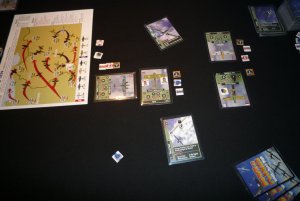
The Poland 1939 campaign game
You have to choose your bombing target carefully since you need a certain number of victory points to win the game and victory points are accumulated by shooting down aircraft (each aircraft has a certain VP value) and by destroying targets. Since the defense rating is similar to the VP rating, destroying a target with low defenses scores few victory points while flying against a target with very high defenses requires that your bombers survive the first six dogfight rounds and the flak unharmed before dropping the bombs to cause enough damage to score these points.
Each target has a flak rating. The defender secretly chooses a flak pattern at setup (dispersed, normal, tight). Dispersed flak always hits all surviving bombers with a number of hits half the flak rating. Normal flak only hits bombers flying a normal or tight bombing pattern and applies as many hits as the flak value. Tight flak only hits bombers flying in tight formation and causes twice the number of hits than the flak value. A chit with the chosen flak pattern is put face down on the campaign sheet.
It then takes exactly six turns (or as many turns as indicated on the campaign sheet, if you don’t play Poland) until the bombers are considered to be over the target. Until then, normal dogfight ensues, with the only exception that bombers don’t maneuver and are limited in their card hand and card selection. After six turns, if any bombers have survived, the owner declares which bombing pattern he will use.
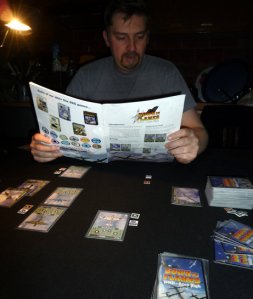
Consulting the rules…
Altitude doesn’t have any impact on bombing; bombers are forced to fly on the altitude mentioned on their card, but this doesn’t make any difference for the bombing. There are no more different types of bombing (the classic DiF has saturation bombing, strafing, level bombing and torpedos), instead, bombers have a fixed number of bombs (and a reduced number on the back of their card that counts if they are damaged). This number is simply the number of hits a bomber will apply automatically if he survives the flak, modified by the bombing pattern he chooses.
Each bomber can choose between dispersed bombing, normal bombing, and tight bombing. The effects are similar to the flak patterns, so bombers using dispersed bombing apply half the number of hits to the target, normal bombing applies the number of hits (=bombs), a tight pattern applies twice the number of hits.
After declaring the bombing pattern, the defender shows which flak pattern he selected. Flak damage is then applied. Bombers which survived the flak now automatically apply their hits. Mission over.
This bombing is extremely anticlimactic. You play a normal dogfight, except that the bombers use special rules and cannot take an active part in the dogfights, then you flip two chits, compare the patterns as in rock-paper-scissors, see if any bombers survive, see how many hits are inflicted to the target, write the numbers down on the campaign log sheet and select the next mission.
It was the declared intention of the designer to eliminate the “luck element” from the campaign game. In addition, he had the impression that the original DiF community was divided into two factions, the “dogfighters” and the “campaigners”. He wanted the campaigns to be more accessible for the “dogfight” faction and appeal to “casual” as well as to “serious” gamers. That’s all fine, but it led to the decision of drastically simplifying the campaign game – which for us (as DiF veterans) is no longer any fun to play.
The former campaign variant had an own rulebook and lots of additional rules which simulated bombers, bombing, distance, time, flying in formations, fighter escorts, and flak. In the new rulebook, the rules describing bombers and bombing cover only a handful of pages which is a first indication of how much was deleted from the original game. Here the designer clearly did overshoot the mark, at least if he wanted to appeal to veteran DiF players as well as to new players!
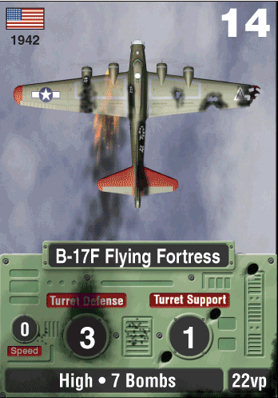
The famous B-17 “Flying Fortress”, damaged side
What was eliminated from the original campaign game?
You will discover the first differences when you take a look at the bomber cards. There are no more heavy, medium, and light bombers (well, there are, but it isn’t relevant for gameplay any more and you won’t find the information printed on the cards, so you will never know).
Take a look at the B-17 card. “High” is the altitude you must choose during setup. The B-17 won’t leave this altitude during the game and bombing from “high” altitude isn’t any different from bombing from a “low” altitude – it’s just you fly, you survive, you hit, you score.
Bombers have a speed rating (important for speed maneuvering if a fighter wants to gain position against the bomber). They then have a turret defense and a turret support rating. The turret defense indicates how many cards the bomber’s owner draws if the bomber is engaged by an enemy fighter. Any adjacent bombers add their turret support rating to this card draw.
Bombers can only play “In my sights” and “Out of the sun” cards in defense. They cannot react or respond to maneuvers (which is historically accurate, a B-17 F didn’t make any Yo-Yos, Barrel Rolls, or Vertical Rolls). Bombers cannot play attack cards on their turn as offense, even if tailed by an enemy fighter, they only defend with attack cards. The attacker, on the other hand, can avoid the bomber’s turrets by playing responses.
“7 Bombs” means that the bomber has 7 bombs on board. If it survives enemy Flak, he will score 7 hits against the target if he chooses a normal bombing pattern. In a dispersed pattern, it will apply 4 hits. In a tight bombing pattern, it causes 14 hits. But a surviving bomber will definitely hit, no surprises here for the pilots/players.
If the bomber is shot down, it is worth 22 Victory Points. The airframe rating is 14.
Bombers cannot conduct saturation bombing, dive bombing, level bombing or strafing. They don’t draw cards when they bomb and there are no more vital, direct, or critical hits on the target – and no more misses. The same is true for the flak, it cannot miss and it will always hit. This is the result of the designer’s frustration with preparing a bombing raid for over an hour which is then spoiled by an unlucky card draw. He admits that, in reality, bombers didn’t always hit the target and of course the automatic hit procedure is extremely gamey. But this was his design decision to make the game more attractive to non-campaigners. Fine, but to us he simply destroyed tension until the very last-minute and the element of surprise in a very fine game by doing so.
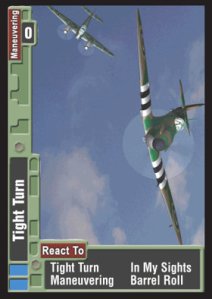
“Tight Turn” is a “React-Only” card, you cannot maneuver with this card, or conduct any other action
Unfortunately, to players who are accustomed to the elaborate classic campaigns, the new campaigns are much too simplified to be entertaining at all. In most of our campaign games, we did some dogfighting and most of the time, our bombers were shot down before they reached the target. When they managed to reach the target, revealing a bombing pattern chit, followed by revealing a flak pattern chit, was extremely boring, so the end-game of each mission was absolutely anticlimactic and it simply didn’t feel right.
In the original game, the fun began when the target area was reached. You had to decide whether you wanted to take your fighters with you into the flak or better break off. Then, the flak fired at your bombers and, to be honest, drawing cards and anxiously waiting for the results was intense and exciting and fun. The same was true for the bombing procedure. Dropping your bombs, not knowing whether you will hit the target and how close your bombs will hit the target, was exciting and not frustrating at all, it was actually the reason to play this game!
Each bomb symbol on the drawn card caused an adrenaline rush, while the “Miss” symbol caused real physical pain… anybody able to get deeply into a game will know what we mean, a die result can be felt in your guts sometimes. There is nothing exciting about flipping chits and applying automatic hits and there’s no ‘gut feeling’ in the Aces High campaign game, it’s as exciting as drinking a glass of water…
All other tiny details are also removed from the campaign. You don’t have any bomber crews, there is no loaded penalty, no night-fighters, no drop fuel tanks, nothing left. And, what is most important, absolutely nothing happens after the dogfight and bombing / flak chit reveal. In the original game, you had to bring your boys safe home after the bombing was conducted, that was part of the story each campaign was able to tell the players. The defender could still follow your bombers making it a hard trip for the crews, you had to endure more flak, you could even be ambushed. You never knew how long a mission would take and you could be taken aback by a longer home-bound phase than you had expected. In the classic series of DiF, something actually happened when playing the campaigns. Compared to that, the DVG version of the campaigns just feels shallow.
It all leads to a simplified, gamey, and unspectacular mission which doesn’t have much in common with a mission from the original game. It’s true, the campaigns are now very user-friendly and dogfight-friendly (you don’t have to do anything else besides dogfighting and chit revealing and your game still doesn’t take more than a fixed number of turns), but don’t expect any simulative aspects and historical accuracy here. There is not much suspense in the new missions and the “feel” is not very realistic. In fact, you are condemned to watching your bombers being attacked by enemy fighters, you try to shoot down the defenders and try to let your bombers survive until the final turn. They can’t do much besides drawing their mini hand, hoping for an attack card in defense, and if they don’t draw an attack card, they are simply shot down. The most you can do is keeping your hand of cards, even if you don’t have any attack cards, just to bluff your opponent that you still could have such a card, but that’s it. Most of the time the bombers will simply be attacked no matter how many cards the bomber player has in their hand, because it’s likelier that there are no attack cards in the mini hand than that there are, so shoot away. When the final turn is reached, the game is over after counting how many bombers dropped how many bombs.
In addition, you don’t have many bombers at your disposal. It’s cool that bombers always fly in formations and give each other support, and it’s also cool that fighters can now fill in empty positions within bomber formations… but most of the time, you are only flying with 1-2 bombers which doesn’t feel very powerful or authentic. I’m missing massive bomber formations, darkening the skies, escorted by squadrons of fighters, and met by defending fighters. There were definitely more fighters and bombers in the original campaigns, but that’s probably also because of the “keep it simple” concept where too many aircraft would overtax the target group.
So this is meant as a severe warning to wargamers who are fans of the original campaigns: you won’t enjoy the new campaign system. “Dogfighters” or casual gamers might enjoy the “Dogfight with a bonus ending”, but if you are accustomed to the classic campaigns, you will be heavily disappointed and even shocked by the simplification. We know that we were, we sat there and were stunned by all the things… that did not happen in this game.
Creativity
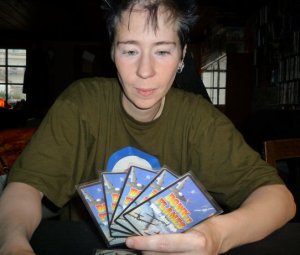
Down in Flames – Aces High is the relaunched, revised version of the original Down in Flames series. It’s certainly not “Advanced Down in Flames” and while the game offers nice ideas in refining the aircraft cards and maneuvering rules, it doesn’t reinvent the wheel and it takes more away than it adds.
It is obvious that the game is based on the original Down in Flames. It tries to make things better, and sometimes, it even succeeds. Splitting damage into firepower and burst was a good idea which adds more detail. Speed and maneuvering feel more dynamic now and the new action cards enrich the action deck.
On the other hand, dumbing down the campaign beyond recognition isn’t too creative or innovative. The game was adjusted to please a new (and probably broader) target group, but all in all, it didn’t bring much innovation or creativity to the old game system, but took away many hallmark features of the classic series.
Historical accuracy was sacrificed for more dynamics and a simpler, more accessible gameplay with fewer rules, but in the end, the campaign system of the old GMT Down in Flames offered more creativity in portraying actual WWII air combat (and still does, of course!) than Aces High.
Simulation Value
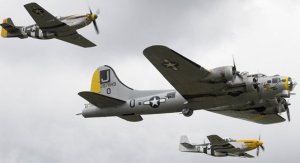
How gamey or simulative is DiF?
The simulation value definitely suffers from the simplification and the new mechanics. While the new dogfight mechanics are dynamic and enjoyable because they allow for more maneuver, they are not as historically accurate as the more ‘static’ dogfights in the original game.
The campaigns lost their simulation value. While the campaigns in the original game were quite simulative on a medium complexity level and appealing to historical wargamers and consim players, the new campaigns are robbed of most simulative and accurate details. Flak and bombers always hit without any luck element, there are no more different types of bombers, fighters are immune to flak, altitude and bomber type don’t play any role in the bombing process, no ingress, no egress. That may be appealing to casual players who enjoy dogfighting and who don’t care about historical accuracy as long as the game doesn’t take too long, the rulebook doesn’t have too many page, and the game doesn’t include any frustrating elements.
Design for Effect can be a good thing, using abstractions to simulate real life aspects in a clever way can deliver an impressive feeling of immersion, but it’s neither Design for Effect nor clever abstraction that was used in Aces High, it’s simply the removal of things that did work fine in the series so far (there’s always room for improvement and things can always be done better, no question, but the classic DiF at least works in both departments: simulation and fun).
The simulation value of the GMT version is much higher than in Aces High, especially regarding bombing. Only the improved fighter stats in the new game offer more simulation value than the fighters in the original game, but in terms of stats only – the overall dogfight gameplay is not closer to reality, quite the contrary, it’s more dynamic than the original for gameplay and entertainment purposes.
Solitaire Suitability
Low. This is a card game where you surprise your opponent by responding to their flight maneuvers with your flight maneuvers. It’s not very entertaining to outrun a fighter which cannot respond to your maneuvers – and you know it. This is a game where you would have to “forget” your other card hands temporarily, so Aces High isn’t a solitaire game in the first place.
Sure, you could pit your fighters against each other, or play a campaign, but if you know the flak pattern already, what fun is it to secretly decide which bombing pattern to use? Aces High is definitely a multiplayer game for a minimum of 2 players.
Can be compared to…
Well, this game is sold as a revised and improved version of the original GMT game, so it must tolerate being compared with the classic Down in Flames series. The differences between both games were detailed in this review, so we don’t have to point them out again. Aces High is the simplified version of a classic wargame with some improvements and many changes for the worst (at least from a wargamer’s perspective who enjoyed the campaigns of the original game). The game appeals to a different audience, and does surely have its fans who enjoy the more dynamic and lively dogfights, and even the simplified campaigns.
Other card-based games dealing with air combat are the Wings of War series, but Wings of War is much simpler. Other games portraying air combat in WWII are Achtung Spitfire! which is a true consim, or the solitaire/cooperative London’s Burning which uses a slightly similar altitude system.
Denny Koch’s conclusion
As I mentioned before, it wasn’t our attention to bash the game.
There are many good aspects in Aces High. I really like the improved fighters with their new stats. The maneuvering with action cards is a great improvement and adds tactical decisions to the game. The new artworks are awesome and the cards are looking great. The refined action cards are a true improvement.
I can imagine that the game is really attractive for new players who don’t know the original game – or who played the original game and didn’t like the static dogfights or the complicated campaign rules. The game certainly appeals to young new gamers and this is always good, the wargaming community needs fresh blood and attractive looking, fast-paced games are perfect for attracting players who are accustomed to PC and video games.
But I am an old-school wargamer who enjoyed the classic Down in Flames series and who isn’t afraid of old-fashioned rules monsters like Advanced Squad Leader, Totaler Krieg, Vietnam 1965-1975, or Imperium Romanum II. I enjoyed the original Down in Flames because it wasn’t a simple fun wargame like Wings of War but offered at least some historical accuracy on a medium complexity level. The campaigns were always the heart and soul of the Down in Flames system – and the fact that it is now reduced to a mere dogfight game (best played 1 vs 1 fighter) took me by surprise.
When I first read that original designer Dan Verssen published a DiF of his own, I was very excited. What he announced sounded promising: more detailed fighter stats, revised rules, more action cards, more maneuver, more dynamics, more flexibility. Even the “elimination of the luck element in the campaign” sounded promising at first because “skill based campaigns” where your success is based on the parts of the mission you have control over” sounds appealing to a wargamer who enjoys historical accurate simulations and games. As a “goodie”, the new artworks were much more attractive than the original ones which were printed in 3 colors back in 1993 and showed rather technical, unspectacular images.
We have many “Advanced” versions of classic games which greatly improve the game, not only because of the modern graphics but also because the designers or publishers took the chance to streamline and clarify the rules, integrate all errata and remove all confusions which became obvious over the last years. Examples of games which highly profit from their relaunch were The Russian Campaign (L2), A House Divided, and, of course, Advanced Squad Leader.
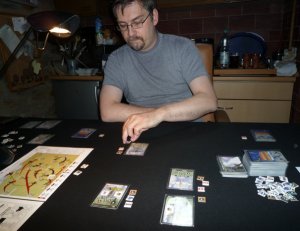
Playing the Poland campaign
When we heard that Dan Verssen wanted to draw a line under the old series which suffered from several rule books, superseding each other, cards which had a different layout, expansion confusion, out-of-print problems with the starter modules etc., we immediately felt reminded of the good old Squad Leader. We had played Squad Leader for a long time, but the confusion resulting from the use of several rule books (“gamettes”) where rules contradicted or superseded each other, was so painful that we switched over to Advanced Squad Leader which contains all rules in a rearranged, revised, clarified and improved version, adding many new rules, and providing a new game while maintaining the same “gameplay feel” as the old game.
So when we read about Aces High, we expected it to be something like the ASL of Down in Flames: a new game which makes things better than the predecessor, which eliminates problems and weaknesses of the original game while adding new spice, new rules, new features, a modern design. Instead of having several modules with several rules versions, the idea of starting with a fresh series and a clean start appealed to us and we bought Aces High, the starter module which was recently expanded by Guns Blazing (we didn’t play this yet, and don’t think we will spend money on purchasing this game because we were so disappointed by the first game. I don’t know if Guns Blazing changes anything and re-introduces more complexity to the campaign, but I doubt it).
We were positively surprised by the high production quality, the strong glossy cards, the great artworks, and enjoyed even the box art. The rulebook looked good at first glance, especially the illustrations. After our first read-through, be became somewhat sceptic. First, the fact that the rules were written for 1 vs 1 aircraft was not very helpful. We didn’t want to play 1 vs 1 aircraft, we wanted to play with at least 2 aircraft each which was the minimum element for having an interesting game from what we knew from the classic DiF dogfights.
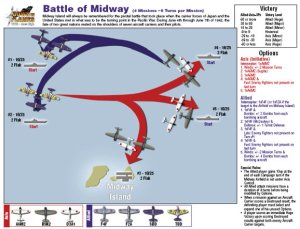
Aces High contains Pacific and ETO campaigns
While playing our first few dogfights, we came across some imprecise wording and were somewhat alienated by the fact that using multiple aircraft counted as an “optional rule”. I mean, are there really players out there who are satisfied with playing 1 vs 1 dogfights for the rest of their lives? You could use one aircraft for your very first introductory game, but I cannot image that you don’t want to command a second aircraft in your second game.
During the first time in our HFC test lab, we only played various constellations of dogfights, and we had skipped the bomber and campaign sections of the rulebook. So our first impression of Aces High was positive – we discovered that maneuver was much more dynamic and that there was more movement and more combat on the table (even for the sake of historical accuracy concerning wingmen, but what the hell, dogfights are meant for fun!). We were not very happy with the rules wording, but the game showed its potential – the maneuvering, the new action cards, the improved fighters, the artworks convinced us that the new dogfight game was cooler than the static and somewhat cumbersome GMT dogfight game.
When we switched over to our first campaign (Poland), we were shocked. The campaign rules were reduced from a 22 pages rulebook to only a handful of pages in the new rulebook. The new campaign sheets with the arrows looks appealing at first glance, but we really soon discovered what was missing from the campaigns – almost everything we enjoyed in the classic game.
As I said before, the new campaign game is nothing more than dogfight with a bonus ending (dogfight + flip the chit) and we didn’t enjoy our games very much. If we didn’t know the original game, we probably would have enjoyed the “extended dogfighting rules” which now includes bombers and flak and stuff, but since we played the original game, we only felt what was missing. The entire feeling of conducting a mission was gone, everything that make the mission interesting, suspenseful, challenging, exciting. Seeing the missions reduced to an extended dogfight came to us like a shock and we were heavily disappointed.
I cannot judge how a beginner or a casual gamer feels when he plays the campaign – he probably enjoys the extended dogfighting options -, but I know how a wargamer feels who loved the original campaigns. The GMT game wasn’t perfect, the campaigns had problems of their own, dogfights sometimes felt static, and the rules wording was often cumbersome or confusing. But the campaigns were still the heart and soul of the old Down in Flames and they were exciting until the very last-minute. You could even successfully bomb your target – and still be unpleasantly surprised on your way back home. There was an early game, a mid-game, and an end-game. Aces High doesn’t have anything like that.
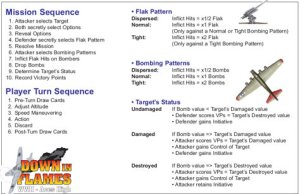
The Turn Sequence is printed at the bottom of the Campaign Log Sheet
In my opinion, Aces High has many good ideas which would certainly enrich the original game. But it is not the game I expected, it is not a revised, clarified, improved version of the old Down in Flames. Instead, it’s a dynamic dogfighting game with an additional light campaign mode for ‘dogfighters who want to play several missions in a row’.
My hopes are now that GMT’s Wild Blue Yonder will also improve things (while still remaining compatible with the old games), but without throwing the heart of the game over board. A combination of Aces High‘s good ideas (the new fighters, the new action cards with maneuver) and the classic Down in Flames campaign system would be the perfect game.
I can recommend Aces High to enthusiastic, easy-going dogfight fans who want fast and simple gameplay while enjoying modern dramatic graphics and who dislike long and complex rules and don’t care much about historical accuracy and simulation.If you don’t know the original game (or didn’t like it), you could take a look at Aces High and the new simplified DVG series.
If you are an experienced wargamer who is looking for an updated version of GMT’s Down in Flames, look elsewhere! You will be heavily disappointed by the simplification and only mourn the improvements which have so much potential… but are built into the wrong game!
End of story is, Aces High is not the game you are looking for if you are a fan of the GMT Down in Flames campaigns or if you are interested in historical accuracy and detail. The fighters are fine, the improved stats work well, but you won’t enjoy the campaigns.
My warning goes to all fans of the old series, especially die-hard campaign gamers. Don’t sell your old GMT games when thinking about “switching to the new system”! Don’t blind-buy the new series! Buy Aces High and play some dogfights and campaigns, and then you will know really soon whether the new Down in Flames is the game for you… or if it isn’t.
Of all my accomplishments I may have achieved during the war,
I am proudest of the fact that I never lost a wingman.
— Colonel Erich ‘Bubi’ Hartmann, GAF.
Our Rating (1-10): (Rating for experienced DiF players / Rating for casual gamers who don’t know the original)
Graphic Presentation: 9
Rules: 6
Playability: 6/8
Replay Value: 3/9
Overall Rating: 5/8



Pascal said
Quote:” A combination of Aces High‘s good ideas (the new fighters, the new action cards with maneuver) and the classic Down in Flames campaign system would be the perfect game.”
So if I own the two games (Luftwaffe-Zero / Ace high-Gun blazing-Wingman expansion) it’ll be little work to use GMT campaign with DVG dogfight!
Anonymous said
The word “aircraft” is both singular and plural. There is/are no “aircrafts.”
Andreas Ludwig said
Thank you – corrected 🙂